True.
Then, in my particular case, with all the hot shots I didn´t charge them .... but their producers 😱
Straight at "the office".
No big deal, they knew the custom built stuff was needed, no problem or arguing on that, only they asked for an inflated bill, anything from 20% to 50% up to 100% in a few extreme cases.
"But ... but ... they won´t pay it!!!! They already don´t want to pay the regular price!!!"
"Leave that to ME, I am the one selling the stadium tickets, collecting record sales royalties, TV show appearances, Tour fees, Publicity and Merchandising, and paying all expenses,including yours"
They robbed "Stars" at gunpoint, without a gun.
Half of it to put money in their own pockets, half so "Artist" could never ever have enough money to produce own shows, Tours, Albums,etc.
Money was carefully released to Artists so they could Party, enjoy, smoke/snort/inject vile chemicals,etc. , but NOT become independent.
I am talking Artists who filled Luna Park (our Madison Square Garden version)

FIFA World Cup River Plate Stadium, etc. , just do the Math on ticket revenues ... and yet are always owing money to the Producer, to be repaid with future Concerts and record sales.
Producers will cater to anything they ask: a Symphonic Orchestra on stage? ... an impressive light show, stage setup ... clothing ... fireworks? ... you name it you have it.
In any and all cases it ends up being paid for by Artists themselves, but they never have direct control of Money.
Then, in my particular case, with all the hot shots I didn´t charge them .... but their producers 😱
Straight at "the office".
No big deal, they knew the custom built stuff was needed, no problem or arguing on that, only they asked for an inflated bill, anything from 20% to 50% up to 100% in a few extreme cases.
"But ... but ... they won´t pay it!!!! They already don´t want to pay the regular price!!!"
"Leave that to ME, I am the one selling the stadium tickets, collecting record sales royalties, TV show appearances, Tour fees, Publicity and Merchandising, and paying all expenses,including yours"
They robbed "Stars" at gunpoint, without a gun.
Half of it to put money in their own pockets, half so "Artist" could never ever have enough money to produce own shows, Tours, Albums,etc.
Money was carefully released to Artists so they could Party, enjoy, smoke/snort/inject vile chemicals,etc. , but NOT become independent.
I am talking Artists who filled Luna Park (our Madison Square Garden version)

FIFA World Cup River Plate Stadium, etc. , just do the Math on ticket revenues ... and yet are always owing money to the Producer, to be repaid with future Concerts and record sales.
Producers will cater to anything they ask: a Symphonic Orchestra on stage? ... an impressive light show, stage setup ... clothing ... fireworks? ... you name it you have it.
In any and all cases it ends up being paid for by Artists themselves, but they never have direct control of Money.
Technically I was not an Olson employee, I was an independent contractor to run the service department. I was not on the payroll, but at the end of each week I turned in a worksheet listing all of the repairs for which the store got paid, all of the repairs for Olson branded stuff that was under warranty, and stuff that was under Craig Pioneer or Garrard warranty. I got three different checks, a weekly check from the Olson store, and monthly checks from Craig and Garrard. If I sold anything during my duty as a repair person, I was supposed to get the usual sales commission, AND any bonus commission associated with a particular item, usually sales duds that needed incentive, or new stuff like the AR speakers, the receiver or turntable.Once, a long time ago, I remember a woman came in with a 1940's Bendix brand AM table radio.
So, a guy I will call Old Hippie pulls up in front of the store in a new Corvette, comes into the store and wants "the best stereo system we have." Olson was owned by Teledyne at the time and so was Acoustic Research, so we sold the entire AR line, and the salespeople got a fat bonus commission on all AR stuff. It takes two trips for Old Hippie to get all of his newly purchased AR stuff home. He had a pair of the big AR speakers, the new AR receiver, and the AR turntable.
Two or three days later he is back with one of the big AR speakers and says, "it sounds bad." I hooked it up, and it did sound bad, fried voice coil kinda bad, so Old Hippie leaves with a new speaker.
A few days later Old Hippie is back with a second dead speaker. He is rather unhappy and wants to return the whole system. The a$$ hole manager is furious and orders me to deliver a second new speaker to Old Hippie's place, hook it up and figure out how this is happening. Now, Mr. Manager wants me to get into my personal car and drive to an angry customer's house and convince him to keep the system so that he doesn't lose a sale, and I don't even get paid for the trip? I try to follow Old Hippie's Corvette in a 65 Pontiac Grand Prix and did eventually find the house. Everything looks properly connected, so I ask Old Hippie to show me how he fried two speakers. At this point he takes out the Led Zeppelin II album, cues up "Whole Lotta Love" and dimes the volume control. Apparently, the AR receiver which was rated at 65 WPC was capable of frying the biggest of the AR speakers., so I explained it this way to OLD hippie. He needed two more of those big AR speakers. This would make the system louder and eliminate the fried speakers. He went for it, and I never got the commission, or the bonus associated with that sale or any compensation for my time and gas money.
That.... is called "abuse", and not covered by any warranty that I'd ever give. - or for that matter from a manufacturer.so I ask Old Hippie to show me how he fried two speakers. At this point he takes out the Led Zeppelin II album, cues up "Whole Lotta Love" and dimes the volume control.
It's simply not normal use for a consumer product.
The shells for most cameras are in top and bottom halves, injection molded, or machined after casting.
They are then joined using fasteners.
Zenit had a unique design, the entire shell was a single piece casting, which was later machined.
Casting wastage must have been high...
They are then joined using fasteners.
Zenit had a unique design, the entire shell was a single piece casting, which was later machined.
Casting wastage must have been high...
So, buying the recommended "high end" component system from a single manufacturer and simply running it at full volume is "abuse?" A little Googling tells me that the speakers were likely AR-3a's or AR-3ax's based on size and weight. Both were intended for "Amplifiers up to 100 Watts per channel" with a nominal impedance of 4 ohms. The AR receiver of the day (1972) was rated at 65 WPC into 4 ohms and 50 WPC into 8 ohms. The 4 speaker setup I did were wired in series for lower total power output, but it was louder, especially outdoors where he often used it.That.... is called "abuse", and not covered by any warranty that I'd ever give. - or for that matter from a manufacturer.
It's simply not normal use for a consumer product.
I owned a Fisher 500TX (50 WPC on a good day) at the same time and that thing ran at full tilt for hours whenever my parents were not home. Nothing blew up. My DIY speakers were LOUD. The AR's of the day were not, as their efficiency was lousy. Cranking them up full was barely audible outside at the street in front of Old Hippie's house. In the end Old Hippie was satisfied, the manager kept his $50 (my guess) bonus commission for the second set of speakers, and I got screwed. A few more of these kinds of incidents led the entire 3 person service department to walk out the door in December of 1972, never to return. This was after I had accepted the job at Motorola in November, but there nobody knew that.
I think that we have wandered too far away from camera sales, so I will not comment further on HiFi sales or repairs here, though the parallels are somewhat similar.
I guess taking a new pocket Rollei 35 camera outside for a day of shooting in -27 degree weather is also abuse because it died, permanently and could not be fixed as the permanently mounted lens had come loose tearing the flex circuit that operated it. My old Ricoh failed to function that day but recovered after a day indoors. The old Yashicamat 6X6 TLR soldiered on and provided the only pictures from my venture into the "blizzard of 1979" in Rochester Minnesota. Unlike some winter days here, I looked like the avatar in the Michelin tire ads on that trip as it was beyond cold there with wind chill indexes hovering between -50 to -60 degrees F. A professional photographer convinced me not to use Kodacolor film in sub zero weather due to unpredictable color shift, so I shot everything on Ektachrome 100. I had a development process for skipping the reversal step and making unmasked (not orange colored) negatives. A Black and white developer was used for step one, so Acufine or Diafine could be used to get high ASA ratings out of Ektachrome 400. This was my secret for clandestine indoor rock concert pictures and other low light shots until the pocket Rollei died.
So, buying the recommended "high end" component system from a single manufacturer and simply running it at full volume is "abuse?"
I owned a Fisher 500TX (50 WPC on a good day) at the same time and that thing ran at full tilt for hours whenever my parents were not home. Nothing blew up. My DIY speakers were LOUD.
Home entertainment products are fundamentally designed by the manufacturer for normal home use.
And just because they have a volume control that turns up to '10' doesn't guarantee that they'll survive long at that level.
If a consumer wants to rattle the walls and disturb neighbors at triple-digit decibel levels, then there are more suitable products designed for extreme sound levels and outdoor venue use - they're called commercial Pro products, PA systems.
I guess taking a new pocket Rollei 35 camera outside for a day of shooting in -27 degree weather is also abuse because it died, permanently and could not be fixed as the permanently mounted lens had come loose tearing the flex circuit that operated it.
And I'd guess that using products like that camera in extremely cold weather is not a wise move, due to materials becoming brittle in minus-degree situations and compromising reliability.
There is sensible use, and then there is a thing called 'pushing the limits'. - which in my opinion is stupid or childish to even defend.
Maybe I expect too much since I spent my career designing radio equipment where someone's life could depend on it operating properly every time it was used even under extreme conditions like inside a burning building. I design my audio amps the same way. it should be impossible for someone to blow it up from outside the box at any and all possible combinations of user operated control settings or input conditions, including line voltage within reasonable limits. I test every one of my "home audio" creations with a guitar preamp cranked 10+ dB into clipping. This would be called "abuse" by most manufacturers, and this use was clearly called abuse by Carver in the manual of their M-400 Magnetic Field Amplifier. What do you think I did with mine? Do I expect some people to do the same with my amps? Yes, I can't be the only one out there that would do this, which has proven to be a correct assumption here on this forum and in other places. Some users here have done things to their amps that I didn't even think of.Home entertainment products are fundamentally designed by the manufacturer for normal home use.
And just because they have a volume control that turns up to '10' doesn't guarantee that they'll survive long at that level.
If a consumer wants to rattle the walls and disturb neighbors at triple-digit decibel levels, then there are more suitable products designed for extreme sound levels and outdoor venue use - they're called commercial Pro products, PA systems.
Early on in my career I built test and trim fixtures for the factory. I was told to build it as if the user was an ape, and even then, the line workers will kill it. My first test fixture lasted three days in the wilds of the production line. They had broken an SMA connector in half. It also had all sorts of nasties engraved into it by the trim laser that it was used in. Lesson #1, use no plastic and use type N connectors and an adaptor to SMA. Adapters are easier to swap out than a fixture so there is less down time on the line. #2, Sometimes, down time is NOT accidental.
Yes, it's possible today to go into a large musical instrument store and get, or order, a commercial grade or "pro" PA system or amp. Peavey and several other big names are readily available to the high end audio consumer. This was not the case in 1972. The benchmark amps for PA systems in 1972 was the Crown DC 300 ($700 each) or the McIntosh MI-350 / MC3500 ($1100 each mono amp), neither of which were easily obtainable by an average consumer who would wander into Olson Electronics instead of HiFi Associates which was the only high end audio game in town in 1972. HiFi Associates also sold the same AR system since it was the accepted high end of the consumer audio. They did not sell the pro grade McIntosh or Crown amps. I only went there for grill cloth, everything else was beyond my price range.
Maybe expecting a cheap camera that was offered as an incentive to open a savings account at a local bank to actually work was a stretch, but it worked far better than I expected and was small enough to stuff in a pocket. OK, I killed it. Expecting as pro quality camera like the Ricoh to live in conditions where humans often had to work should be expected. It was however at least 15 years old at the time so having the shutter refuse to move while cold could be expected. The Yashicamat was however a flea market find for $10 and it offered my first (of many) foray into large format film. It always worked like a champ until it died due to sudden deceleration one day while trying to climb a tree with too many camera straps over my shoulder. Yes, I killed another. It would not be my last camera murder. My old Pentax died from being dropped. It still worked but had a light leak that killed its usefulness.And I'd guess that using products like that camera in extremely cold weather is not a wise move, due to materials becoming brittle in minus-degree situations and compromising reliability.
There is sensible use, and then there is a thing called 'pushing the limits'. - which in my opinion is stupid or childish to even defend.
I'm with you.
Unless the system was clipping badly (which I am sure you would have mentioned) then simply playing loud is not abuse.
And it was a 'system', not a mishmash of components.
Unless the system was clipping badly (which I am sure you would have mentioned) then simply playing loud is not abuse.
And it was a 'system', not a mishmash of components.
Being quite familier with the Acoustic Research amps and receivers, I can state the fact that they do not perform well under extreme conditions, nor were they designed to.I'm with you.
Unless the system was clipping badly (which I am sure you would have mentioned) then simply playing loud is not abuse.
And it was a 'system', not a mishmash of components.
They are fragile in their design, and are notorious for blowing output transistors, among other issues.
Pushing them to clipping also is a bad idea.
I never liked them, had them in the shop for repairs enough of times.
Please consider that way back then voice coils were made out of cellulose paper, think printer type or best case brown Kraft cement bag grade, cellulose dehydrates and becomes brittle about 80C; maybe 90C for Kraft type, toasts at 100C (Cellulose is simply a longer chain of morning coffee grade sugar) ; "speaker cement", the "universal adhesive" was nitrocellulose (basically same as smokeless powder and old style movie film) dissolved in acetone + some aromatic esther and you´ll understand why even "Large Pro" speakers with their huge 3" or 4" voice coils inside gigantic magnets were rated 60 or 50W RMS ... and even so were regularly blown by Guitar players.
We are talking Altec or JBL here 😱
A 2" voice coil, the largest ever used by AR could not have stood more than 30-35W RMS, continuous tone or reasonably clipped Music, and probably less.
The "up to 100W" rating meant: "yes, you can use it with a 100W Amp (which anyway would be "IHF" or "Music" or "Program" watts)" but it was expected that the average listener would listen to Classic or Mantovani or Ray Coniff or Jazz or Sergio Mendes with the amp still quite clean, meaning a low duty cycle.
So yes, full tilt Led Zeppelin would blow almost anything.
We are talking Altec or JBL here 😱
A 2" voice coil, the largest ever used by AR could not have stood more than 30-35W RMS, continuous tone or reasonably clipped Music, and probably less.
The "up to 100W" rating meant: "yes, you can use it with a 100W Amp (which anyway would be "IHF" or "Music" or "Program" watts)" but it was expected that the average listener would listen to Classic or Mantovani or Ray Coniff or Jazz or Sergio Mendes with the amp still quite clean, meaning a low duty cycle.
So yes, full tilt Led Zeppelin would blow almost anything.
Excellent post!Please consider that way back then voice coils were made out of cellulose paper, think printer type or best case brown Kraft cement bag grade, cellulose dehydrates and becomes brittle about 80C; maybe 90C for Kraft type, toasts at 100C (Cellulose is simply a longer chain of morning coffee grade sugar) ; "speaker cement", the "universal adhesive" was nitrocellulose (basically same as smokeless powder and old style movie film) dissolved in acetone + some aromatic esther and you´ll understand why even "Large Pro" speakers with their huge 3" or 4" voice coils inside gigantic magnets were rated 60 or 50W RMS ... and even so were regularly blown by Guitar players.
We are talking Altec or JBL here 😱
A 2" voice coil, the largest ever used by AR could not have stood more than 30-35W RMS, continuous tone or reasonably clipped Music, and probably less.
The "up to 100W" rating meant: "yes, you can use it with a 100W Amp (which anyway would be "IHF" or "Music" or "Program" watts)" but it was expected that the average listener would listen to Classic or Mantovani or Ray Coniff or Jazz or Sergio Mendes with the amp still quite clean, meaning a low duty cycle.
So yes, full tilt Led Zeppelin would blow almost anything.
Even the AR LST, a beast at 100LBS, had its limits.
"Long Term" wattage use = 23 watts.
64 watts for 30 seconds.
When I was there I heard no obvious clipping. I also learned early on in the car stereo world that blatant clipping usually fries the tweeter first.I'm with you.
Unless the system was clipping badly (which I am sure you would have mentioned) then simply playing loud is not abuse.
And it was a 'system', not a mishmash of components.
I don't know much, or really care about AR speakers or their equipment We sold several in the year that Teledyne owned both Olson and AR. This was the only time I ever "fixed" one. We sold a lot of Fisher too and I fixed lots of them. The tin plated connectors on the wiring harness turned green and went intermittent in the Florida humidity often within the first year of use, especially in a college dorm room. At any rate this was 50 years ago, why argue about it today. I will continue to design to "abuse resistant" standards, while the world seems to want unrepairable electronics that go out of fashion before they die.
Watching a lot of videos on YT on photography and related DIY equipment. The concept of cages and associated gear is quite interesting. There is a series of in-depth videos by Scott Walker who specialises in bird digital photography which I found great. He touches not only on the physical gear, but his methods for post-processing.
I also found lens adapters very interesting. I've done a small but interesting number or experiments on efficient power for lighting that could be useful in photography as well, like lighting 98 LEDs with a single AA battery.
Been experimenting with the camera of an iPhone 8. iPhones have an internal digital magnifier but it's not directly accessible. Works quite well. Things like micro-soldering become possible. I also combined it with an old Canon Kit lens that I bought from a thrift store and obtained some closer images like that. Yes, old iPhone, but I never had to bought one, my own cellphone is the original Google Nexus One. iPhones trickle down to me when my wife decides to buy herself a new one.
Things like microscopes and macro-photography are usually very interesting to me.
A frugal way to do several things like cinematic movies, macro-photography, wide-angle landscape, etc... is ultimately the goal but as a hobbyist.
I also found lens adapters very interesting. I've done a small but interesting number or experiments on efficient power for lighting that could be useful in photography as well, like lighting 98 LEDs with a single AA battery.
Been experimenting with the camera of an iPhone 8. iPhones have an internal digital magnifier but it's not directly accessible. Works quite well. Things like micro-soldering become possible. I also combined it with an old Canon Kit lens that I bought from a thrift store and obtained some closer images like that. Yes, old iPhone, but I never had to bought one, my own cellphone is the original Google Nexus One. iPhones trickle down to me when my wife decides to buy herself a new one.
Things like microscopes and macro-photography are usually very interesting to me.
A frugal way to do several things like cinematic movies, macro-photography, wide-angle landscape, etc... is ultimately the goal but as a hobbyist.
.. on the speakers and volume front. back when there were still hi fi stores where you could listen to stuff, I would always take in some Zappa and crank it up high - sometimes the staff looked nervous but no speakers ever died. If a system you are buying won't take that, it should say so in big letters on the box... 🙂
I've never understood why speaker manufacturers don't put any protection into the design.
I've never understood why speaker manufacturers don't put any protection into the design.
The avatar's name is "Bibendum"The old Yashicamat 6X6 TLR soldiered on and provided the only pictures from my venture into the "blizzard of 1979" in Rochester Minnesota. Unlike some winter days here, I looked like the avatar in the Michelin tire ads on that trip as it was beyond cold there with wind chill indexes hovering between -50 to -60 degrees F.
Please consider that way back then voice coils were made out of cellulose paper, think printer type or best case brown Kraft cement bag grade, cellulose dehydrates and becomes brittle about 80C; maybe 90C for Kraft type, toasts at 100C (Cellulose is simply a longer chain of morning coffee grade sugar) ; "speaker cement", the "universal adhesive" was nitrocellulose (basically same as smokeless powder and old style movie film) dissolved in acetone + some aromatic esther and you´ll understand why even "Large Pro" speakers with their huge 3" or 4" voice coils inside gigantic magnets were rated 60 or 50W RMS ... and even so were regularly blown by Guitar players.
We are talking Altec or JBL here 😱
Talking about cameras, film and cellulose. Major event in Cleveland OH history was "The Cleveland Clinic Fire of 1929" when the nitrocellulose X-ray films stored in the basement spontaneously caught fire, killing 123 people.
Then we got "safety film".
Eastman Kodak (we are talking photography here) hived off its chemicals business in the 1990's as Eastman Chemical (and a good thing too). They were one of the largest producers of cigarette filter "tow", a cellulosic product, as well as polyesters, acrylics etc. The company was hounded by analysts thinking that "tow" was too large a part of their business. Thus they acquired Solutia in 2012. There is a lot of very interesting product development around natural organic chemical intermediates with the advent of high powered computer simulation in their skunk works.
When F1 was here, from my 14-yr old Canon Point-and-Shoot. I doubt I did any manual adjustment apart from Zooming, and there's no post-processing:

Long ago they ran a "Grand Prix Americas" series through the streets of downtown Miami almost every year. The main event was an American Le Mans series race. There were all sorts of other supporting racing events on the same weekend. I spent a day at the races almost 20 years ago, in September of 2003. My friends and I had "All Access Passes" for the day courtesy of Microchip who was a sponsor of the Johnson Controls car. They even brought a couple of their own "race vehicles" for us to "race."
Our "racing" was "supervised" by the Miami Police department. In reality there were tens of millions of dollars worth of "stuff" in the park that day. The cops, private security, and government people watching the stuff and the crowd that day. CBS was filming a Grand Prix related Episode of CSI Miami, a TV show in the VIP area where we were playing with the Segways. The film crew was not happy with us zipping through "their set" which apparently included the entire pit and the VIP area.
Ford filled the infield with lots of eye candy and the usual Nascar and NHRA top fuel cars. Pointing the camera in the other direction across the infield, which is Bayfront Park shows the northern end of Biscayne Bay, and Miami Beach on the other side of the bay. The top of a cruise ship can be seen to the right of the light pole. This is all the "pretty side" of Miami, which had some extra polish put on it for the large amount of money that was in town that weekend. I grew up about 15 miles Southwest of here in a "not so pretty" part of town.
This car existed only as a rumor at the time, so this was only a mirage which was parked among a collection of neat, but not particularly rare Ford products. This rumor sparked to life and zoomed around the track once during the morning practice session, then returned to its parking place. The rumor turned into a real product about a year later.
Here's a car getting a tune-up in the pits. This is a standard Motorola "Jedi" police walkie talkie strapped in for a very fast ride. It's used for car to pit communication. I was in the design team that created that radio and it contains some circuitry that I designed.
The old digital Nikon wasn't fast enough to catch any good pictures of cars going over 100 MPH when they are about 50 feet away.
Our "racing" was "supervised" by the Miami Police department. In reality there were tens of millions of dollars worth of "stuff" in the park that day. The cops, private security, and government people watching the stuff and the crowd that day. CBS was filming a Grand Prix related Episode of CSI Miami, a TV show in the VIP area where we were playing with the Segways. The film crew was not happy with us zipping through "their set" which apparently included the entire pit and the VIP area.
Ford filled the infield with lots of eye candy and the usual Nascar and NHRA top fuel cars. Pointing the camera in the other direction across the infield, which is Bayfront Park shows the northern end of Biscayne Bay, and Miami Beach on the other side of the bay. The top of a cruise ship can be seen to the right of the light pole. This is all the "pretty side" of Miami, which had some extra polish put on it for the large amount of money that was in town that weekend. I grew up about 15 miles Southwest of here in a "not so pretty" part of town.
This car existed only as a rumor at the time, so this was only a mirage which was parked among a collection of neat, but not particularly rare Ford products. This rumor sparked to life and zoomed around the track once during the morning practice session, then returned to its parking place. The rumor turned into a real product about a year later.
Here's a car getting a tune-up in the pits. This is a standard Motorola "Jedi" police walkie talkie strapped in for a very fast ride. It's used for car to pit communication. I was in the design team that created that radio and it contains some circuitry that I designed.
The old digital Nikon wasn't fast enough to catch any good pictures of cars going over 100 MPH when they are about 50 feet away.
Attachments
-
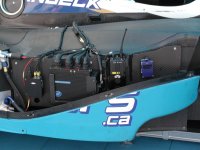 DSCN4072.JPG712.6 KB · Views: 76
DSCN4072.JPG712.6 KB · Views: 76 -
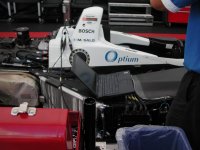 DSCN3978.JPG578.8 KB · Views: 80
DSCN3978.JPG578.8 KB · Views: 80 -
 DSCN4110.JPG834.9 KB · Views: 100
DSCN4110.JPG834.9 KB · Views: 100 -
 DSCN4021.JPG830.2 KB · Views: 74
DSCN4021.JPG830.2 KB · Views: 74 -
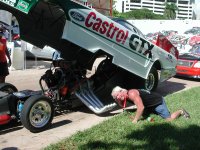 DSCN4027.JPG868.1 KB · Views: 74
DSCN4027.JPG868.1 KB · Views: 74 -
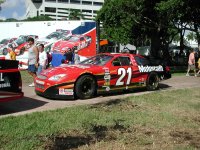 DSCN4029.JPG991.3 KB · Views: 97
DSCN4029.JPG991.3 KB · Views: 97 -
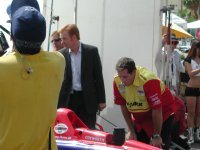 DSCN4095.JPG500.6 KB · Views: 77
DSCN4095.JPG500.6 KB · Views: 77 -
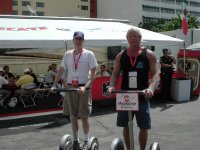 DSCN4100.JPG720 KB · Views: 80
DSCN4100.JPG720 KB · Views: 80 -
 DSCN3980.JPG751.5 KB · Views: 83
DSCN3980.JPG751.5 KB · Views: 83 -
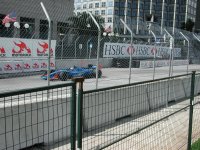 DSCN4042.JPG1 MB · Views: 79
DSCN4042.JPG1 MB · Views: 79
-27º (assuming Fahrenheit) is -32ºC. Definitely nippy but not super cold. Many parts of Canada and quite a few parts of the US sit around there for a good chunk of the winter. Yet, many cameras are only spec'ed to -5ºC. Below that all bets are off. I find that pretty lame. Apparently the manufacturers have never heard of winter photography.I guess taking a new pocket Rollei 35 camera outside for a day of shooting in -27 degree weather is also abuse because it died, permanently and could not be fixed as the permanently mounted lens had come loose tearing the flex circuit that operated it.
Tom
- Home
- Member Areas
- The Lounge
- Camera sales have fallen